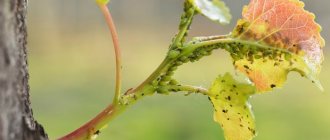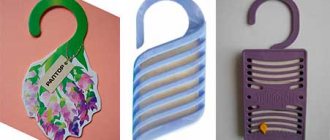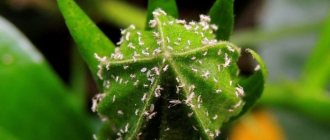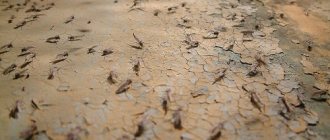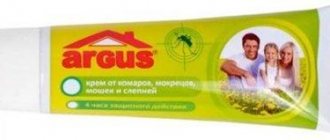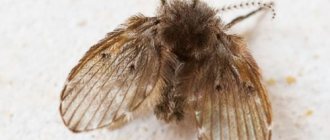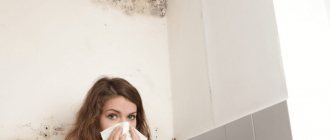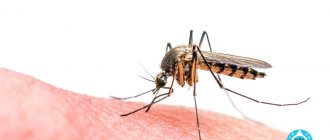Do round and oval holes appear on the trunks of weakened, sickly trees, around which heaps of white or brown small sawdust continually form? Suddenly, out of the blue, a woodpecker settled on them? In this case, you urgently need to look for a highly effective remedy for the bark beetle, an insect pest that can destroy the garden and significantly damage wooden buildings. The modern market offers quite powerful chemical preparations, but if the situation is not yet so advanced, folk methods of struggle can also be a way out.
Features and danger of bark beetles
The bark beetle is a small insect that feeds on wood. Pests go through several stages of development:
- Eggs . After mating, the adult female gnaws her way deep into the tree, where she leaves the clutch.
- Larva . From the moment the eggs are laid to the next stage, an average of 7-10 days pass. The larvae are small white-transparent worms that are voracious. By eating the sap and fibers of the tree, they move inside the trunk and leave passages behind them.
- Doll . The period of transformation of a larva into a pupa takes on average 2-3 years.
- Adult . The beetle reaches a size of 4-6 cm, the surface of its body is covered with a chitinous shell of dark brown or black color, and there are club-shaped antennae on the head. Appearance may vary depending on the type of insect.
The borer goes through 4 stages of development: eggs, larva, pupa, adult
It is better to start pest control at the larval stage. However, it is quite difficult to find them, since they are located deep in the trees, do not crawl out and are able to withstand temperature fluctuations from −30 to +38 ℃.
Bark beetles are found primarily in temperate regions. Their favorite wood is spruce, fir, pine, cedar, and in the absence of these species, they do not disdain other trees. In this case, preference is given to wood affected by the fungus.
The bark beetle poses a danger not only to trees in the garden, but also to wooden buildings (baths, houses, sheds, gazebos), as well as pieces of furniture
The main danger of pests is damage to trees or wood products. They eat wood, breaking through passages and spreading fungal spores through them, which accelerates the destruction of the tree from the inside. Therefore, a tree that is intact and healthy on the outside may turn out to be rotten on the inside. This is especially dangerous for load-bearing structures and supports, which can collapse at any moment, causing significant damage.
Bark beetles do not pose a danger to humans. They do not bite, do not transmit infections and do not provoke allergic reactions. But for houses and furniture made of wood, small bugs can be destructive.
Confidor Extra
A broad-spectrum insecticide that helps get rid of several types of insects, including bark beetles. Long-term protection, a method of controlling pests that feed on wood through the gastrointestinal tract.
Advantages:
- used not only on trees, but also on garden crops, shrubs, etc.;
- promotes restoration of damaged parts of the trunk;
- acts deeply;
- quickly copes with the task, from 2 to 48 hours;
- does not wash off in the rain, works for a long time.
Flaws:
- works only on those beetles that feed, has no effect on larvae or sleeping ones;
- toxic, protective equipment required.
It is prohibited to spray chemicals near the residence of dogs, cats or bees. For affected areas, a single treatment of the wood is sufficient. Release form: water-soluble granules (WG). It works on the principle of contact-intestinal influence. For 10 liters of water, 2.5 ml of the drug; if there are a lot of beetles, increase the concentration by 2 times. Initially, dissolve the granules in a small amount of water, mix thoroughly, and add the rest of the liquid.
Treats affected areas, destroys mold and mildew. It is valid all season; before spraying, protect the soil and everything nearby. It is safe for humans, but can harm beneficial insects, underground inhabitants and pets.
According to buyers, it does its job well and is safe for plants. Suitable as a way to combat severe cases, even in hot weather. One treatment is enough for the whole summer. Effective against bark beetle and most types of insects that eat wood.
Causes and signs of appearance
The main reasons for the appearance of bark beetles in wooden houses:
- high humidity, which leads to wood damage by fungus;
- improper or insufficient wood processing;
- use of low-quality materials for construction;
- purchasing wooden furniture made from infected wood.
It is almost impossible to identify pests in a residential area, since they settle deep in the wood, and crawl out only when the raw material becomes unsuitable for life and food. However, if you are careful, you can notice the first signs of pests. Upon careful examination, small holes (up to 2 mm in diameter) and remains of brown flour (recycled wood) are found, and rustling noises are heard at night.
In the garden, a visual inspection of the trees will help determine the presence of pests - they begin to dry out, and the passages of the borer can be seen under the bark. You can see what it looks like in the photo below.
The appearance of bark beetles is indicated by the presence of small holes and passages that are visible under the bark of trees or on affected wooden products
How to find out about danger
In a wooden house, the fight against the bark beetle begins with its detection. There are several alarm bells that will indicate its presence on the premises. What you need to do to avoid missing them:
- Carefully inspect the walls, ceilings, floors, baseboards, ceilings, and wooden furniture.
- Find small holes in them.
- Notice fine sawdust dust, white or brownish, on the floor, near the baseboards.
- Hear a strange crunching noise coming from the walls at night, reminiscent of a clock ticking. This bark beetle sharpens wood, as it wakes up only with the onset of darkness.
- The easiest way to detect a bark beetle is on the ceiling, because dust will fall from it and whole pieces of wood will begin to fall off if there are a large number of passages.
When purchasing a wooden house, carefully inspect it for the presence of insect pests. Often owners, unable to get rid of them, sell their mansions literally for next to nothing.
This is interesting. In ancient times, the crunching sound coming from wooden walls at night instilled superstitious fear in people. They had no idea that it was coming from a bark beetle and called it a “death clock” because it resembled a ticking sound.
Mechanical methods of pest control
A radical way to get rid of bark beetles is to dismantle and burn the affected wood. This method is used in exceptional cases, as it has a number of disadvantages:
- damage to the integrity of wooden structures is required;
- it is impossible to be absolutely sure that the remaining elements of the structure are not affected by pests;
- effective only at the initial stage of bark beetle reproduction.
XILIX Gel
XILIX Gel gets rid of all wood pests. This professional biocide effectively removes mold, mildew, insects, and larvae. It also treats affected areas of houses and forms effective protection.
How XILIX Gel works
The drug protects and rids wood of parasites. The white gel-like substance acts as an insecticide. Contains permethrin (0.51%), which resists sucking and leaf-eating pests. Eliminates organisms resistant to organophosphorus insecticides. The drug is dangerous for cats .
A gel with significant penetration properties penetrates deeply to a distance of 10 cm from the surface and does not drain. Kills adult insects and larvae. Propiconazole in the composition prevents the appearance of mold and fungi. Fungal spores do not settle on the surface of the wood product. Due to the thixotropic formulation, the drug acts without loss of properties in a thick wood layer. The number of passes to obtain a therapeutic effect is reduced.
Benefits of the gel
XILIX Gel is an innovation in methodological approaches to getting rid of tree pests. Advantages:
- resistance to mold, mildew, wood pests, including larvae, eggs;
- deep penetrating ability due to a special formula;
- Possibility of use outside and inside housing;
- long-term preservation of the effect (there will be no secondary infection for 10 years);
- safety for humans, the environment and pets (excluding cats);
- suitable for all wood species;
- does not change the color of the wood, does not leave stains;
- no smell;
- acceptable cost.
The best place to order XILIX GEL treatment is from. The specialists passed prof. training and have all the necessary equipment to provide the highest quality services.
Preparation for the procedure and application of XILIX Gel
Before processing, you need to consider: the use of XILIX Gel requires professional assistance, since special equipment is used. Xilix Gel is applied by spraying with a painting unit with a hydrodynamic pump:
- GRACO;
- WAGNER;
- TITAN.
First comes the preparation of the wood. It is cleaned of dirt and dust. Old paintwork or other coatings are removed. The wood is sanded to remove loose layers using professional equipment. Damaged wood elements must be replaced before applying Xilix Gel.
The gel contains a fluorescent pigment, so you can monitor the quality of the coating. The pigment appears about a month after application of the drug. XILIX Gel is used at temperatures above 0 °C, wood moisture content is not more than 25%.
The product is applied by applying one to three layers to the wood, depending on the thickness, type, and humidity of the substrate under low pressure (maximum 5 bar). In areas where application of the gel is difficult, parenteral injection of the drug into the drilled holes is carried out to ensure complete impregnation. Spraying is important for wood with a significant diameter or wood that is difficult to access from several sides.
Working diagram:
- Inspect the facility, carry out calculations of chemical consumption.
- Prepare part of the base for application.
- Apply the drug.
- Check the results.
Xilix Gel for bugs and fungus
The drug is used for prophylactic or therapeutic purposes. For prevention:
- insect eggs die because they are in the upper woody layer and are the first to be affected by the drug;
- females are unable to lay eggs;
- the larvae present cannot resist the action of the drug and die;
- fungal spores do not settle, do not multiply, and do not survive.
During treatment:
- the drug prevents the formation of mold and fungi;
- The product kills various insects, adults and larvae. The drug is quickly absorbed, penetrates 10 cm from the surface or more, and effectively fights even pests hidden deep inside.
XILIX Gel is an active substance manufactured by a manufacturer from France. Sold in the form of a gel, its purpose is to treat wood to get rid of insects, mold, and mildew. There are no similar preparations in the Russian Federation with a similar formula, thanks to which the gel penetrates into the deep layers of wood. A 10-year guarantee on the effectiveness of the treatment is provided. This is an effective drug for treating wood and preventing destruction due to pests.
XILIX Gel
Fumigation
Fumigation using phosphine or magtoxin gases will help control pests. The poisonous gas penetrates the passages of insects, destroying eggs, larvae, pupae and adults. Carrying out aeration should be entrusted to specialists in order to achieve maximum results in the fight against parasites and avoid poisoning and other negative consequences.
During fumigation, the outside of a wooden house is covered with a special dome, which prevents the spread of gas throughout the area and increases the efficiency of treating the structure.
Disadvantages of fumigation:
- high price;
- the need to attract specialists;
- high toxicity of the gas used;
- After etching, degassing is required to disintegrate the phosphine particles.
Pheromone trap
Mechanical methods of influence include a pheromone trap. This biological method is environmentally friendly, safe for people and animals. The trap is a plastic structure containing a pheromone inside. The beetles flock to the attractive aroma, hit the partition and fall to the bottom of the container, from where they cannot escape. The principle of operation of the pheromone trap is described in detail in the video:
It is important to understand that a pheromone trap is effective for catching only adult individuals, and it can also work the other way around - attracting insects from other territories that will not fall into the trap, but will settle in trees, destroying them.
Microwave devices
Devices emitting high-frequency electromagnetic waves will help fight pests in a wooden house. The microwave emitter heats the wood to high temperatures (+60 ℃), which effectively destroys insects at different stages of development. This method is safe for the building and residents, but requires compliance with certain safety measures, so it is better to entrust the work to specialists.
Preventive measures to combat bark beetles in homes
You can stop the appearance of bark beetle in a wooden house using preventive methods. It is better to start fighting it in the area adjacent to the house and garden.
- To clean the forest and reduce the number of harmful insects, attract birds, install feeders and birdhouses. Recognized “forest orderlies” improve their own habitat, getting rid of unwanted neighbors and human habitation.
- Timely cleaning of the forest from dead wood, fallen trees, stumps, and dead branches will significantly reduce the number of convenient habitats for pests. It is necessary to regularly thin out the crowns, remove and take away cut branches, and clean the area of fallen leaves in the spring. All these places are attractive for insects that feed on wood.
- As a preventive measure, treating tree trunks with a solution of slaked lime is good. For 1 part lime, take 3 parts water, mix gently and wait 2-3 hours for the reaction to occur. This phase is characterized by heating and active bubbling, then hissing. When the solution “calms down”, stir again and begin processing. The treatment should be carried out with glasses and gloves. Whitewashing is done with a simple paint brush. Bleached trunks are protected from the risk of bark beetle infection.
- At the end of flowering of the fruit trees, the mass emergence of the beetle begins. To destroy adult individuals, spraying with Lepidocid and Boverin is used. They kill pests, but do not cause damage to plantings, and are safe for the soil. Repeated spraying is carried out after a couple of weeks.
- One of the methods of prevention is regular inspection of tree trunks on the site and the surrounding area to detect woodworm passages and holes in the trunk. The first signs of damage are a reason to treat with insecticides. Biologically active preparations of targeted action are designed to combat specific types of insects. They are safe for birds and pets.
- Large affected areas require more effective means. Chemical agents have sufficient power and paralyzing effect on pests. The drug Candifor Extra has a penetrating effect into the thickness of the wood and is destructive for insects that have climbed deep into the thickness of the trunk. The clipper preparation is intended for processing bark. It attacks the digestive system of pests while devouring wood.
- If the tree is significantly damaged, it is better to give up trying to save it. The site will be greatly benefited by cutting it down, uprooting the stump and burning wood debris.
As a preventative measure, it is necessary to monitor the humidity in your own home, since the bark beetle prefers to settle in damp wood. A hygrometer and a household dehumidifier will help regulate the microclimate. If the walls are damp, heat the house, use a heater or heat gun. A fan set to heating mode will also help. Ventilate the room regularly by opening all doors and windows wide to allow air movement. A musty, moldy smell can also indicate high humidity.
If the attic or attic is filled with junk, old furniture, and wooden rubbish, this creates an additional risk of bark beetle infection. You should clean regularly and get rid of old and unnecessary things.
Coating with varnish and paint will help protect wooden surfaces from bark beetles. To care for varnished surfaces, special polishes are used. They also contain substances that repel insects, and wax seals small cracks. In addition, after treatment with Gloss or Polish, wooden elements acquire an attractive appearance.
If varnishing or painting is not provided for the design of a wooden surface, preventive treatment with sodium fluoride can be carried out. For 10 liters of hot water, take 250 g of dry product and mix. When the liquid has cooled, soak a soft cloth or sponge in the solution and wipe the wooden structures. If you find holes in the tree, you need to take more active action.
The use of folk remedies
Folk remedies will help you get rid of bark beetles in a wooden house. They are used for treating wood with a sponge or spray at home, as well as for filling bark beetle burrows. Effective recipes for killing beetles:
- mix kerosene and turpentine in a ratio of 1:3. Saturate the outside of the wood with the resulting product and inject it into the tunnels using a syringe;
- combine naphthalene, tar and turpentine in a ratio of 1:1:3. Mix all the ingredients and introduce the mixture into the holes left by the bark beetles;
- melt the paraffin and add crushed rosin to it (proportion 5:4). Bring the mixture to a boil, add vegetable oil and simmer for another 2 minutes. Introduce the cooled mixture into the insect passages.
After treating the wood, fill all holes with silicone or acrylic sealant. This will block the escape routes and destroy the insects that managed to survive the first stage of persecution.
To protect against bark beetles, the wood should be covered with hot drying oil. It is used not only for external treatment, but is also poured into insect passages to destroy them.
Prevention of bark beetle infection
The best method of controlling bark beetles in a wooden house is prevention. What kind of wood does not infest the bark beetle? There is only one answer - treated with special bioprotective substances. Prevention should begin before construction begins, when choosing lumber for building a house:
- you should ask the supplier about the availability and processing method;
- carefully check logs and boards for exit holes;
- for prevention, wooden surfaces should be periodically treated with an insecticide and coated with protective substances;
- remove contaminated parts of wooden parts in a timely manner;
- prevent wood from rotting and moisture accumulation;
- Furniture protection is provided by bio-impregnation. Furniture varnish prevents beetles from penetrating into the wood, and the remaining larvae and eggs will die.
A log house is popular due to its environmental friendliness, low thermal conductivity, and availability of the material. In order for the building to please the owners for many years, timely treatment against the bark beetle is necessary, and in case of infection, you need to know how to remove the bark beetle.
Use of chemicals
Chemicals help remove the bark beetle by destroying adults and larvae. With their help you can process a large number of products, trees or an entire building. However, you should be careful when working with insecticides, as some products may be harmful to animals or people.
The table contains the most effective chemicals that will help cope with woodworms:
| Name | Active substance | Mode of application | Advantages | Flaws |
| "Bi-58" | Dimethoate | The solution is used for spraying plants and wooden buildings | Destroys bark beetles, their larvae and other beetles | To achieve the effect, re-treatment is required after 3 weeks. |
| "Confidor Extra" | Imidacloprid | The solution is prepared according to the instructions, then it is used to process wood products (furniture, sections of beams, panels, etc.) | Effectively fights adult insects and larvae | Repeated processing required |
| NEOMID StopBeetle | Synthetic pyrethroid | The drug is diluted with water in a ratio of 1:4 and is used to impregnate wooden buildings | Suitable for external and internal processing, penetrates deep into wood, does not interfere with further work with wood | Re-processing is required to maintain the effect. |
| "SenezhInsa" | Stabilized aqueous composition of active substances, including technological and functional components | The solution is used to impregnate wood before use in carpentry or construction. | Penetrates deep into the layers of wood, due to which it retains the ability to repel beetles for a long time | Gives untreated wood a greenish tint |
| "Clipper" | Bifethrin | The product is sprayed on trees on the site, pieces of furniture, and wooden floors. | Good penetration | Re-processing required |
Rules for using pesticides to kill pests:
- Read the instructions on the package.
- Take proper safety precautions - wear gloves, a protective suit, a respirator.
- Follow the instructions to avoid poisoning and other consequences.
- After treatment, take a shower.
If none of the presented methods of combating bark beetles brings the expected result and the pests do not leave the house, use the services of exterminators. To combat insects, they use chemicals and mechanical methods.
Traces of a bark beetle on a tree - how to detect?
It is not difficult to determine that pests have settled on a tree. Typically, the insect targets weakened plants. It is on such trees that beetles make their nest, without attracting attention to themselves and without wasting energy on damaging healthy hard wood. Therefore, first of all, weakened plants should be inspected for the presence of insects.
Round and oval holes can be seen on the trunks of affected trees. Such traces will mean that the worms have settled in the tree trunk a long time ago. A woodpecker constantly working on a tree can also be considered a sign of defeat. Most often, the bird hunts for the bark beetle.
Sawdust, which insects throw out of the trunk, forming passages under the bark, can also be considered a sign of infection. Based on the color of the sawdust, you can determine the level of damage to the tree: brown - the bark beetle did not have time to penetrate deep under the bark, white - spraying and any other treatment will most likely not give results, since the insects managed to get too deep.
Prevention of the appearance of bark beetles in a wooden house
In order to preserve a wooden building and avoid the appearance of a grinder, pay special attention to the selection and preparation of wood:
- check the boards before purchasing, inspect them for small holes or passages;
- choose dry wood, since wet wood contains sap that attracts bark beetles;
- when purchasing logs, examine the ends and make sure there are no tunnels;
- treat the material with insecticides and cover with a protective composition;
- Avoid high humidity in the room, prevent wood from rotting and fungus from spreading.
To build a house, choose high-quality dry wood without fungus and signs of the presence of bark beetles.
When buying a wooden house, pay attention to the condition of the wood and the presence of infection, and when moving into a new building, first carry out antiseptic treatment. For prevention, use the chemicals “Ecolan”, “Antizhuk”, “Wood Healer”, etc. The treatment should be carried out three times with an interval of 7 days, so that you can live in the room without fear.
Assess the condition of wooden furniture before purchasing, as unscrupulous manufacturers may use contaminated raw materials for production. After such a product gets into the house, there is a danger that bark beetles will begin to look for new sources of food, attacking other wooden objects.
An integrated approach, which includes the use of mechanical, folk and chemical methods, will help you get rid of the bark beetle in your home or summer cottage. In difficult cases, use the services of exterminators to save your home and avoid its complete destruction.
Attention! In accordance with the legislation of the Russian Federation, copying this article only with the permission of the author. When using materials from the article, links to the site are required!
The fight against bark beetle consists (first of all) in the necessary set of preventive measures. In treatment with special insecticides and biological preparations by spraying over the entire height of the tree and its crown. Also using stem injections, biotechnical and alternative methods.
If the tree is already too severely affected, any treatment will be useless. Such a tree must be removed immediately to avoid the formation of new outbreaks. Even if all the bark beetles are destroyed, the damage left by the bark beetle is often incompatible with the life of the tree. With such damage, the vascular system of the tree is disrupted. In addition, stem pests facilitate the penetration of infections and serve as carriers of vascular and necrosis-cancer diseases.
The most common types of stem pests: typographer, engraver, pine beetle, birch sapwood.
Particular attention should be paid to protecting planted large trees from attacks by bark beetles. Large plantings that are in a stressed state after transplantation are more susceptible to attack by bark beetles and other dangerous pests. We must remember that the bark beetle primarily attacks weakened and diseased trees. Some types of stem pests can pose a deadly threat to a tree. 150-200 bark beetles kill an adult spruce within a month.
Trees infested with stem pests are recognized by the state of the crown, thinned foliage and needles, their yellowing, damaged roots, dark cambium, the presence of drill flour at the base and in cracks in the bark of the trunks, resin funnels and entrance holes of insects, and notches made barbels for laying eggs on the bark of trunks, by abundant drips of resin or sap, and other signs.
It is necessary to carry out surveillance in order to control the emergence, spread and development of dangerous diseases and pests and the condition of green spaces for timely planning and implementation of activities in the required volumes and at optimal times.
Carrying out preventive work according to a schedule drawn up by a specialist guarantees the health of the trees in the forest area and garden. New plant protection technologies provide visible results for a long time.
Methods of controlling the bark beetle.
A set of preventive measures:
- constant monitoring of green spaces;
- exclude the formation of a source of pest spread (removal of garbage, spontaneous landfills during the construction of a house, sanitary felling, sanitary pruning of trees and shrubs, timely removal of infected and dead trees, uprooting or treatment of stumps with special preparations);
- strengthening the immunity of trees;
- Important preventive measures aimed at preventing the emergence of foci of stem pests include the preservation of natural enemies of stem pests (birds and entomophages) and assistance to them;
- protection and attraction of birds is an effective forest protection measure;
- preventive treatments (chemical, biological and alternative, biotechnical method).
If preventive treatments are carried out, then it can be guaranteed that the tree will not be damaged by the bark beetle, even if there are foci of stem pests in nearby areas (neighbors). It is easier to prevent pests and diseases than to cure affected trees!
Chemical method of protection.
Spraying (treatment) with insecticides. Chemical substances used to protect plants are classified according to their chemical composition, objects of use, nature of action and methods of penetration into the body. Only a specialist can understand a large number of pesticides. The chemical method of protection is best used in extreme cases, since this treatment kills not only stem pests, but also beneficial entomophages. Insecticides against bark beetles are toxic and can cause poisoning of birds, animals and humans. The decision about such treatments and the treatments themselves should only be made by a specialist.
Spraying is carried out from April to the end of September, during the summer of young bark beetles (longhorned beetles and borers fly all summer, including September).
The first treatment in April is the most important, before the first flight of the beetle or during the beginning of the flight of the bark beetle. Chemical protection of conifers from the bark beetle is carried out by autumn treatment of its wintering sites (litter in the projection of tree crowns) or by spraying tree crowns with systemic insecticides during the period when it is on the trunks. Treatment of bark beetle wintering sites by dusting or spraying the litter with contact preparations is quite effective, but is complicated by the need to carry it out in an extremely short time. It is carried out in the fall, after the pests have left for the winter in the forest floor at the base of the trunks.
Migration begins in April and continues throughout the summer. The bark beetle is capable of producing several main and sister generations in one summer. The first sign of coniferous trees being damaged by stem pests is severe gumming. This suggests that the tree is protecting itself from bark beetles.
Biological method of protection.
Spraying (treatment) with preparations that do not have a chemical basis. They are absolutely harmless. Biological preparations are biological means of controlling pests and plant pathogens, the active ingredients of which are microorganisms or their metabolites, entomopathogens (viruses, fungi, bacteria, protozoa, nematodes). These drugs are highly effective in the fight against bark beetles and pine beetles of coniferous species, sapwood, borers, longhorned beetles, gypsy moths, and May beetles.
Nematodes
In the former USSR, successful experiments were carried out on the use of entomopathogenic drugs against forest pests. Large commercial firms are developing new forms of bioinsecticides based on the nematode-bacterial complex or nematode-fungal complex.
The drug "Krona Antip" - the active principle of the drug is the strains of entomopathogenic bacteria Xenorhabdus nematophillus isolated from natural isolates. The drug is prepared with a titer of 1 billion microbial cells per 1000 live invasive larvae of the entomopathogenic nematode Pristionchus uniformis v. Oz. The drug is non-toxic for humans and animals. The active principles of the drug are living objects. The biological product is intended to combat bark beetles, sapwood and wood borers. It can also be used against other forest pests (beetles, longhorned beetles, gypsy moths, May beetles).
It should be noted that treatment of trees with nematodes gives a positive result of 70-75%.
Entomophages
Entomophages are beneficial insects that are natural enemies of plant pests - an alternative to the chemical method of pest control.
Based on their feeding method and lifestyle, they are divided into predators and parasites.
Predatory insects are registered in 16 orders and 167 families with a huge number of species.
Most species of predatory Coleoptera (order Coleoptera) from the family. Little tots (Histeridae), Rove rove beetles (Staphylinidae), Sparkles (Nitidulidae), some species from the family. Moths (Cleridae) exterminate bark beetles and other stem pests in the subbark space of drying out or shriveled trees. One of the most active among them is the moth Thanasimus formicarius, called the “bark beetle” for its activity in old entomology textbooks, and the “ant beetle” for its similarity in body shape to an ant. It hunts for bark beetles on tree trunks, and its larvae destroy their eggs, larvae and pupae under the bark.
Forest predators are camels (order Raphidioptera). The most common species in coniferous forests is the thin-whiskered camel (Raphidia ophiopsis). Its larvae feed on insects on trees, crawl into the passages of bark beetles, and are especially willing to destroy pine beetles, as well as eggs of the subbark pine bug, nun bug, and butterfly caterpillars. Among endoparasites, the group of ichneumon is especially diverse in the number of families and species, size, structural features and lifestyle.
Among them there are tiny ichneumon parasites and large parasitic ichneumon parasites that feed on insect larvae living in wood, such as the Rhyssa persuasoria. When laying an egg on its prey, the rider seems to saddle it. The most active parasites among parasites are found in the family. Braconidae and Ichneumonidae, in the above family. Chalcidaceae (Chalcidoidea), uniting a whole group of families.
A preventive measure - the use of entomophages - is the last word in forest science. The first experiments were carried out to launch entomophages on the border of the Moscow region and New Moscow. At a density of 6 individuals per square meter, entomophages destroyed from 40 to 62% of bark beetles. In the wild (in our forests), entomophages destroy only 16-17% of bark beetles.
The Russian market for plant bioprotection products, in particular entomophages, is very poorly developed today. Among domestic manufacturers of entomophages, the market leader is the Russian Agricultural Center, which produces up to 50% of the total volume of entomophages in Russia.
The biological method of protecting plants from pests has a long history. The literature often provides examples of the use of beneficial insects in the citrus plantations of ancient China and the date groves of the medieval Middle East. The first known literary source that described the activities of parasitic insects was the work of Ulysses Aldrovandi, published in 1602. Since that time, on different continents and in different countries, farmers began to successfully use methods of biological plant protection from a variety of harmful organisms.
At the beginning of the 20th century, the biological method gained great popularity in North America. Following America, the biological method began to develop rapidly in Europe. Before the start of the Second World War, this was perhaps the main way of targeting harmful herbivorous organisms in order to reduce damage from them.
Intra-stem injections
The fight against the bark beetle can be carried out using intra-stem injections using the American Arborjet technology. Stem injections protect the tree from stem pests for up to 12 months. With the help of intra-stem injections, the following problems can be solved:
- strengthening the tree's natural immunity
- prevention of pest attacks in outbreaks in nearby forest areas
- prevention of diseases in unfavorable sanitary conditions
- treatment of existing diseases (bacterial, fungal, viral)
- destruction of stem pests that have already entered the tree
- treatment of chronic forms of tree diseases
Alternative method of protection.
A mesh impregnated with a special insecticide.
Biotechnical method of protection.
It is necessary to say separately about pheromone traps and antipheromones. Biotechnical pest control methods are based on the use of chemicals (pathogens, hormones) or physical stimuli to attract or repel harmful insects.
These are chemicals that are safe for humans and attract insects (pheromone traps) or repel pests from a particular tree (antipheromones).
Pheromone traps for stem pests are used in forest protection on large forest areas (from 50 hectares) to control the number of insects (but not to control insects by trapping).
Antipheromones - designed to protect the tree from insect attack during active flight. The principle of operation of this type of trap is based on the use of substances that have a strong effect on the insect body, which are sex hormones - pheromones.
Back in the last century, the French scientist entomologist J.A. Fabre, observing the moths of the Saturnia pear tree, noted an interesting feature: females are able to attract males, and the males fly to them from a very long distance, exceeding several kilometers. Later it was found that during the mating period, females secrete specific substances, which were called sex pheromones. Scientists have managed to artificially create and synthesize sex pheromones of many species of harmful butterflies, first the silkworm, and then other pests.
Sex pheromones are also called sex attractants, and their range currently includes hundreds of items for various insect pests of forests and gardens.
Pheromone traps for stem pests are designed for the needs of forestry, mainly for recording the number of insects and timely detection of emerging outbreaks of mass reproduction of certain pests.
You cannot use them on your own plots!
To maintain a healthy garden and individual trees, we recommend annual monitoring and treatment and preventive measures.
To combat bark beetles, we offer the following insecticides:
Systemic action:
Confidor Extra, VDG (700 g/kg) d.v. imidacloprid bottle 0.5 kg Biscaya, MD (240 g/l) a.v. thiacloprid canister 5 l Operacot Acro, KS (300 g/l + 100 g/l) d.v. imidacloprid + lambda-cyhalothrin canister 5 l Borey, SK (150 + 50 g/l) a.v. imidacloprid + lambda-cyhalothrin 1 l bottle Clonrin, EC (150 g/l + 100 g/l) a.v. zeta-cypermethrin + clothianidin canister 5 l
Contact-intestinal action:
Arrivo, EC (250 g/l) d.v. cypermethrin bottle 1 l Cyperus, EC (250 g/l) a.v. cypermethrin canister 5 l Decis Expert, EC (100 g/l) d.v. deltamethrin canister 5 l Taran, VE (100 g/l) d.v. zeta-cypermethrin canister 5 l Newstar, EC (100 g/l) d.v. zeta-cypermethrin canister 5 l Borey Neo, SK (125 +100 + 50 g/l) a.v. alpha-cypermethrin + imidacloprid + clothianidin 1 l bottle
Biological products:
Fitoverm 5%, CE d.v.
aversectin C is a natural balanced avermectin complex obtained from the waste products of the soil fungus Streptomyces avermitilis. 5 l canister and 1 l bottle Nematodes "Krona Antip" - upon request Copying and rewriting information from the site without written consent from the site administration is prohibited.
